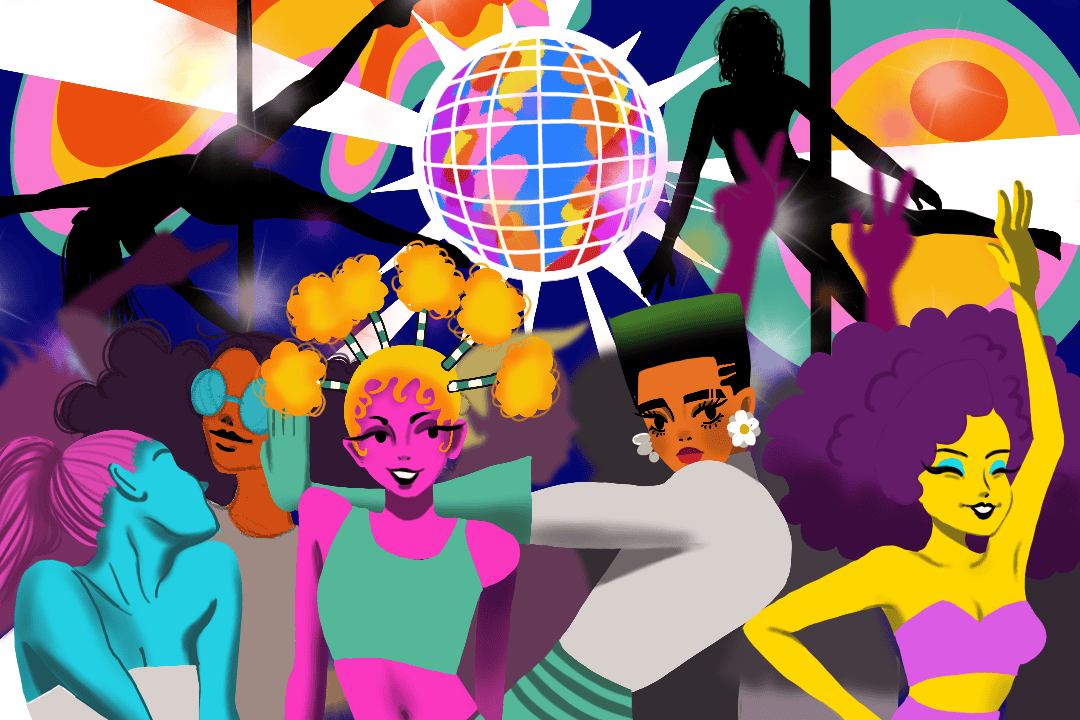Shakedown traces the life of the LA-based Black lesbian strip club of the same name. The documentary, which was made over 15 years and released in 2018, centres on the years 2002–2004 when police forced the club out of its current address in South Central Los Angeles. Combining club footage, event flyers, and present-day interviews, director Leilah Weinraub condensed over 400 hours of material into an entrancing 70 minutes that lingers with you long past the film’s runtime.
Opening with a red screen and glimmering synthesizers, Shakedown ushers viewers into a terrain unbounded by time or place. The names of club staff, including the performers known as the Shakedown Angels, flicker on the screen as 22 chapter titles flash by.
Placed throughout the film are ‘talking heads’: a documentary staple where interview subjects speak while facing a camera. This, along with the brief explanation of the club’s fate at the end of the film, is as faithful to the traditional documentary form as the film gets.
A traditional documentary tends to serve an expository function. It asks its questions and seeks out context and clarification, eventually building to a crescendo of reaching catharsis through revelation. Some kind of reckoning tends to follow this climax: a moment to digest and evaluate the facts that have been unveiled. Inquiry becomes a drama where information flow dictates the emotional pushes and pulls of the story.
Traditional documentaries typically focus on factual details to orient the viewer — dates, times, locations, names, and relationship titles. Shakedown does not pause to explain or accommodate. Despite possessing familiar documentary features like the talking head, Shakedown provides few dates, full names, addresses, or other expected identifiers. Interviewees discuss their experiences at the club, but the audience does not know how they first discovered the club. There is club footage, but the audience is not always told what night or year it was taken in.
Shakedown presents a series of recollections and experiences that are left unlocalized, uncategorized, unidentified, and unclassified. By employing extensive sequences of club footage, Weinraub allows the footage and its subjects to speak for themselves. By not forcing legibility out of the club’s history, Weinraub avoids forcing drama onto it.
Watching Shakedown, I wondered what a documentary was supposed to do for a community if it was uninterested in exposure and dissection.
University of Chicago Professor C. Riley Snorton suggests that Black sexuality exists within a “glass closet.” Because Black sexuality is understood as inherently deviant and potentially dangerous, it becomes the world’s business — which impedes how Black queer folk explore themselves in private. Sexuality becomes a live broadcast distorted behind the metaphorical glass of the closet or the literal glass of the screen.
Although Shakedown is a public work, it does not publicize itself. Weinraub’s efforts to leave archival footage unedited and unexplained keep the lives of this history ungraspable. Although captured in the glass of the camera, the scanning machine, or the screen, these lives do not feel trapped there. The glass only transports them.
Conscious of Black people’s brutal history of being objectified as things to have and use, several Black artists work from a “Black archival impulse,” according to U of T Cinema Studies Institute Associate Professor Lauren Cramer. Instead of collecting Black people and their stories as disposable units of information, the Black archival impulse aims to unite Black audiences in a shared contemplation of a work. Cramer writes in her essay, “The Black Archival Impulse” that, through this assembling of Black audiences around the experiences and memories triggered by an archival work, the Black archival impulse allows the past to remain open and “unsettled.”
Of course, Shakedown cannot completely avoid mediating its history. As art critic and historian Hal Foster describes archives in his essay, “An Archival Impulse” as “found yet constructed, factual yet fictive, public yet private,” documentary-making involves selection: picking and assembling pieces of life to form a whole. As much as the whole arises from what is included, it also arises from what is omitted. In this way, Shakedown thrives on its absence of explanations for the club, its patrons, and its staff.
Archives have the capacity to freeze and imply strict beginnings and endings. Foster, whose concept of the archival impulse Cramer builds upon, writes that the archive is not final in the work of contemporary archival artists. Archival art’s indefinite status encourages the audience to continuously interact with and elaborate upon what they see, providing an alternative to culturally dominant ways of remembering and relating.
Keeping things unknown can be a form of preservation. Archives and documentaries provide information, but what about protecting it?
In her essay, Cramer writes: “[T]he Black archival impulse is to keep elusive memories, to keep memories elusive, and to find ways to gather around these unsettled pasts.” ‘Elusive’ is the word to describe Shakedown — elusive in fact and historical detail but not in its depth of feeling. The catharsis of knowing feels good. However, for some histories, discovery feels like conquest and factual uncovering feels like acquisition.
Some — not all — histories require irresolution, where audiences must sit in an experience whose beginning and end they cannot claim to know. Granting its subject’s silence and its audience an exploratory relationship to revelation, Shakedown is a documentary that unveils without forgetting to protect.



No comments to display.